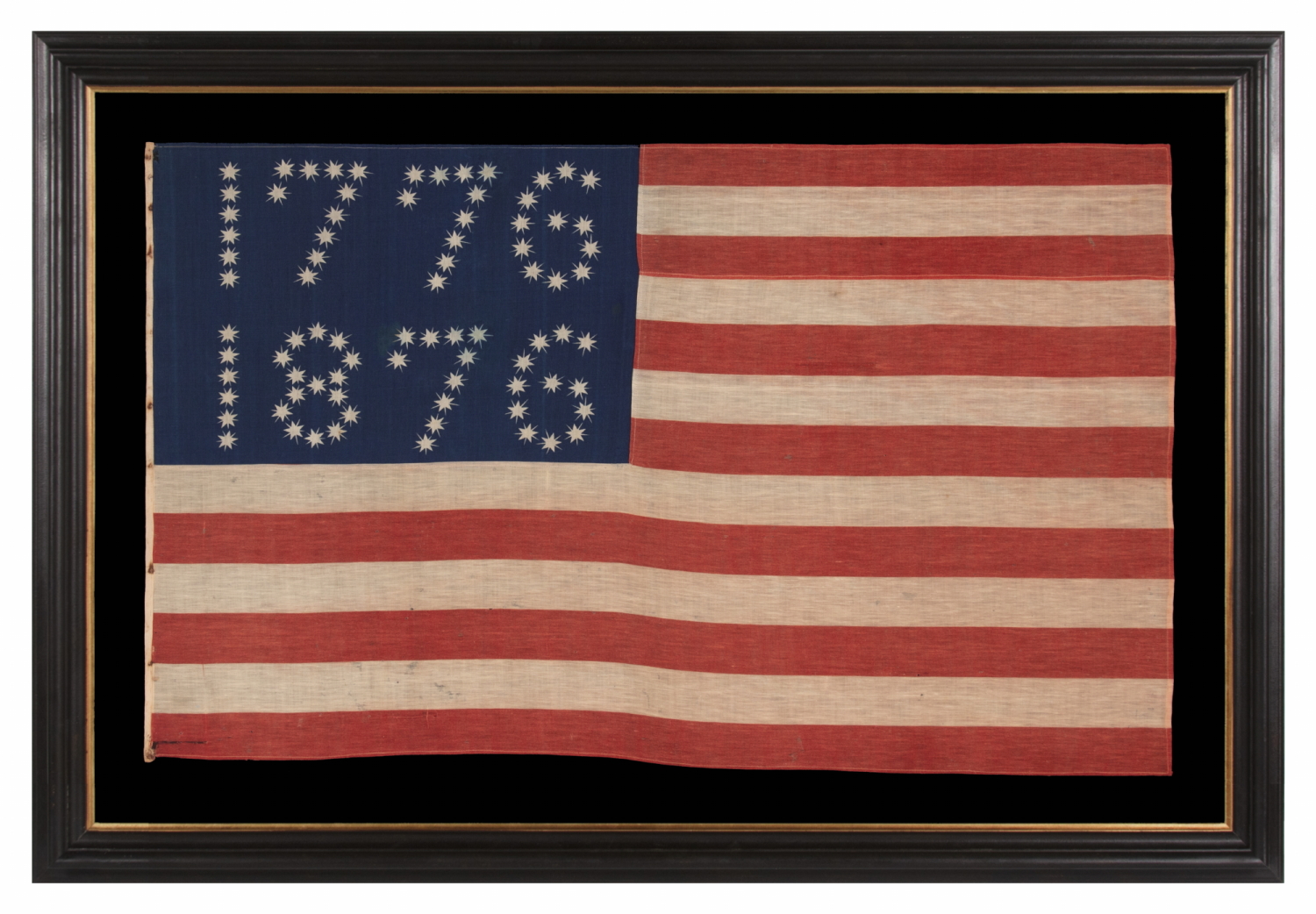
| |
ANTIQUE AMERICAN FLAG WITH 10-POINTED STARS THAT SPELL “1776 – 1876”, MADE FOR THE 100-YEAR ANNIVERSARY OF AMERICAN INDEPENDENCE, ONE OF THE MOST GRAPHIC OF ALL EARLY EXAMPLES |
|
| Available: |
Sold |
| Frame Size (H x L): |
Approx. 41" x 59" |
| Flag Size (H x L): |
29" x 47" |
|
| Description....: |
|
Many fantastic star patterns were made in the patriotism that accompanied the centennial of American independence in 1876, among which this is one of the best of all examples. Furthermore, flags with stars that spell out numeric or alphabetical characters are among the rarest of all configurations in the world of antique American flags, across which just three other styles are presently known to exist.
In the canton of this flag, 38 stars are arranged to form the date “1776”. The star count of 38 reflects Colorado’s pending statehood in that year. 43 additional stars were then used to form “1876,” directly below. This may reflect the supposition that 5 more states would soon join the Union; and though other flags in this period leave blank space open, suggesting similar assumptions, it seems more likely, in this instance, that it simply took 5 more stars to make a “8” than it did to make a “7.”
Note how the stars have 10 points, 5 of which are narrow and fall between the larger arms. This results in a shape that I have always felt to be reminiscent of depictions of the Star of Bethlehem. Whatever the case may be with regard to this observation, their format transmits the sparkling, firework-like qualities of celebration.
Colorado became the 38th state on August 1st, 1876. This was the year of our nation’s 100-year anniversary of independence. Per the Flag Act of 1818, stars were not officially added until the 4th of July following a state's addition. For this reason, 37 was the official star count for the American flag in 1876. Flag-making was a competitive venture, however, and few flag-makers would have been continuing to produce 37 star flags when their competitors were making 38’s. It is for this reason that 38 and 13 stars (to represent the original 13 colonies) are more often seen at the Centennial International Exposition, the six-month long World’s Fair held in Philadelphia in honor of the event. Some flag-makers would have been adding a star for the 38th state even before it entered the Union, in the early part of 1876 or even prior. In fact, many makers of parade flags were actually producing 39 star flags, in hopeful anticipation of the addition of two more Western Territories instead of one. But the 39th state would not join the Union for another 13 years, when the Dakota Territory entered as two states (numbers 39 and 40) on the same day, on November 2nd, 1889.
These particular flags with the 1776-1876 formation would certainly have been displayed at the Centennial International Exposition, the six-month long World’s Fair, held in Philadelphia, that served as the nucleus of the national celebration. More likely than not, they were made specifically for that event. They bear the unusual trait of being printed on a thin fabric made from blended wool and cotton. Most parade flags of this era were printed on 100% cotton or silk, which were impractical for extended exposure to the elements, yet sufficient for most parades, political rallies, and reunions, which typically lasted only a day or two. The reason for the inclusion of wool was that it sheds water, making it an obvious choice for flags that were to be used outdoors for an extended period. The fact that the exposition required flags that could withstand six months of use, caused some makers to consider wool or blended wool fabrics for small-scale, decorative flags. This particular example is constructed of three lengths of fabric that were pieced and joined with treadle stitching. There is a narrow, treadle-sewn binding along the hoist, made of twill weave cotton tape.
Mounting: The flag was mounted and framed within our own conservation department, which is led by expert staff. We take great care in the mounting and preservation of flags and have framed thousands of examples.
The mount was placed in a black-painted, Italian molding with wide, shaped profile and a gilded inner lip. The background is 100% cotton twill, black in color that has been washed and treated for colorfastness. The glazing is U.V. protective acrylic (Plexiglas). Feel free to contact us for more details.
Condition: Overall condition is extraordinary; a 9.5-out-of-10 among known examples. There is a lateral tear at the hoist end of the last red stripe, with very little fabric loss. There are a series of tiny tack holes along the binding, with associated rust stains, where the flag was once affixed to a wooden staff. There are a few pinprick-sized holes in the striped field and a few, minor, weak areas, only one of which displays any significant fabric loss. This is a tiny, horizontal area approximately ¾ of the way across the 5th white stripe, measuring about ¾” x 3/16”. Period fabric of the same type was carefully placed behind this for masking purposes. There is extremely minor bleeding of the red stripes and very minor soiling. Many of my clients prefer early flags to show their age and history of use. |
|
|
|
| Collector Level: |
Flags for the truest Patriots. My best offerings |
|
| Flag Type: |
Parade flag |
|
| Star Count: |
38 |
|
| Earliest Date of Origin: |
1876 |
|
| Latest Date of Origin: |
1876 |
|
| State/Affiliation: |
Colorado |
|
| War Association: |
1866-1890 Indian Wars |
|
| Price: |
SOLD |
|
| |
Views: 1301 |
|
|
|

